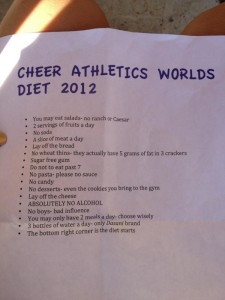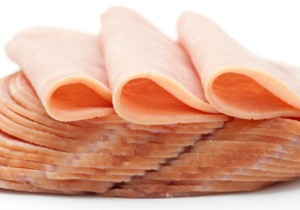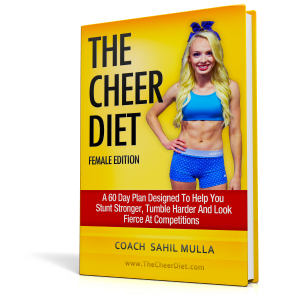 If there is one thing all competitive coaches have in common, it’s that they want to produce results. After all, the whole point of competing is to try and win, is it not?
If there is one thing all competitive coaches have in common, it’s that they want to produce results. After all, the whole point of competing is to try and win, is it not?
But that’s where the similarities end because while the goal of winning remains, the paths that coaches take to reach this goal can vary quite a bit.
One of my core coaching values is: “leave em better than you found em.”
This means that regardless of whether an athlete trains under me for 5 years or 5 months, I do my best to make sure they leave a better version of themselves than before they met me. That’s the path I’ve chosen. As such, my goal here today is to make sure you leave with better and more accurate information than what you initially came in with.
Enter the Cheer Athletics “World’s Diet”

During the launch of my recent book, a reader emailed me asking for my opinion about a diet plan (supposedly designed by CA) which was being mentioned everywhere on Twitter. To be honest, does that surprise anyone? The abs that the girls on CA have are clearly undeniable.
After some initial research I found out that this diet was actually released as a joke between friends. This is easy to spot as the recommendations are clearly absurd (as you’ll soon see).
Unfortunately, a lot of cheerleaders didn’t catch this joke and came to the conclusion that this is how the girls at Cheer Athletics eat.
And so, as this diet went viral, young female athletes everywhere tried to follow it. I quickly realized that should a cheerleader ever attempt this diet while on an intense training program, she’ll be sacrificing her long term health.
…and that is no laughing matter!
So below, I’ll be breaking down this “diet” piece by piece and hopefully, you’ll understand why following it (or any other type of crash diet like it) is not a smart idea.
Sidenote: This article isn’t meant to bash Cheer Athletics. I doubt it was the intention of the athletes for this joke to go viral, but no one can predict such things. So I wanted to do my part, and help steer anyone away from putting their health at risk. What lies below is for educational purposes. It is my hope that any cheerleader that got duped by the joke can learn about what she should really be eating to improve her performance.
Guideline 1: “You may eat salads – no ranch or caesar”
Obviously salads are great, so there are no disagreements there. But I don’t see any reason to bland down a salad and eat it raw just to save a paltry 70 calories. Also, let’s not forget dressings are high in sodium – which for an athlete is essential to consume on a day they’ll not only be performing, but sweating buckets. I’ve competed at Worlds and trust me, the last thing you want to do is eliminate sources of electrolytes.
Guideline 2: “2 servings of fruit per day”
This is actually not a bad recommendation. My only gripe is that because fruits contain simple sugars, athletes should be told the optimal times to consume them so the sugar actually becomes useable fuel in the bloodstream instead of being stored as fat.
Guideline 3: “No Soda”
Can’t argue with this one. However during your offseason, having a can of pop once in a blue moon isn’t going to ruin your tumbling pass.
Guideline 4: “A slice of meat a day”
 I laughed at this (who eats a slice of meat a day?) and figured by now, cheerleaders would surely realize that this was meant as a joke. But nope, I was wrong.
I laughed at this (who eats a slice of meat a day?) and figured by now, cheerleaders would surely realize that this was meant as a joke. But nope, I was wrong.
So let’s get into protein for a second. When athletes don’t get enough protein, things can become sketchy. Let’s not forget that protein is the building block for muscle. A slice of meat contains about 3g of it – if you’re lucky. That amount is almost insignificant. Heck, even if a diet were to recommend “only one serving of meat per day” it wouldn’t be enough to fuel a world-level cheerleader, let alone provide enough protein to heal and repair muscle tissue.
It doesn’t matter what your sport is, protein is the ultimate macronutrient for any serious athlete and needs to be consumed in ample quantities – especially if you’re female.
The Dangers Of Low Protein Intake:
- Breakdown of muscle tissue. After a hard training session, your muscles need protein to recover, but if you aren’t taking in enough, the body has to get it from somewhere. And what’s the only other place it can turn to? The other muscles which weren’t being worked. As an example, say you go through a hard leg training day and fail to consume adequate amounts of protein. What will your body do? Simple, it will pull the amino acids from your arms, abs, chest – basically wherever it feels like it. This is a terrible situation to be in if you’re an athlete.
- Increased weakness. Pulling amino acids from other muscles is a taxing process; it’s not something your body wants to do, but it has to. And as such, there is a price to pay – low energy. Have fun tumbling at a turtle’s pace.
- Weak immune system. For your body to fight off infections, prevent colds and stop other nasty viruses from ruining your day, it needs to produce antibodies. But in order to do that, guess what it needs? Yup, protein!
- Extreme protein deficiency can also lead to shock and other functions of your body completely shutting down. Athletes are at a higher risk because we push our bodies harder than the average person.
How does eating only one meat slice per day sound now?
Ridiculous, I hope.
Guideline 5: “Lay off the bread”
What’s funny about this guideline is that there are some actual diets out there (and even nutritionists) which recommend this.
To be honest, I’m not sure why you would do avoid bread unless you actually hate it. Bread can be one of the cheapest sources of quality carbohydrates, and carbs happen to be your body’s primary fuel source.
This would be like telling a Ferrari owner “hey, you should lay off the premium gas, buddy!”
Guideline 6: “No Wheat Thins – they have 5 grams of fat in 3 crackers”
First of all, 5 grams of fat is nothing. Stressing over such a miniscule amount, or even thinking that it will have an effect on your performance in any way shape or form is laughable. What you need to be concerned with is taking enough fats (especially as a female athlete because fats are crucial for optimal hormone balance) and taking in the right kind.
I wasn’t able to find what type of fat Wheat Thins have, but regardless, you should aim to consume natural saturated fat (such as grass-fed butter or from meats) along with other great sources such as fish oil, olive oil or coconut oil.s
Fat is not the devil, and eating fat will not actually make you fat (contrary to popular belief). Science has shown that simply eating too many calories is the true culprit(1) of obesity. So if Wheat Thins float your boat, have some. I promise you’ll be just fine.
Guideline 7: “Sugar Free Gum”
Meh.
That’s my response to this. Personally speaking though, you should know that the artificial sweetener used in most gums (aspartame) has about 10,000 complaints filed against it to the FDA and can cause some seriously neurological damage in certain individuals. In others, it’s completely safe. So you decide. I tend to stay away from artificial sweeteners as much as possible.
Guideline 8: “Do not eat past 7”
While we now know the CA diet was released as a joke, this recommendation (just like the bread one) is actually still taken very seriously by coaches in many sports. I’ve seen it first hand.
The problem is that there is no evidence behind why you should avoid eating later in the day. Trust me, I tried looking. In fact, one study(2) found that women who ate a majority of their calories during the evening burned more fat and had better body composition than women who ate most of their calories during the day time.
How’s that for a shocker? If you’re interested in a deeper breakdown on meal timing and how it relates to your body burning more fat, I cover that in great detail in my book. But as for now, it seems to me that a better guideline would read like this: “Eat only past 7pm.”
Guideline 9: “No pasta – please no sauce”
Again, this is not the first time I’ve seen poor ol’ pasta being hated on. It’s totally unjustified, especially at Worlds – a time and place when athletes need to be fuelled to the max. Oh and let’s not forget, your brain’s primary (and preferred) source of fuel is glucose, which is sugar. And how do you top up your glucose stores? From carbohydrates. Pasta is one of the best things you can eat 60-90 minutes before stepping on the stage and performing your heart out.
Guideline 10: “No candy”
Some of my best tumbling sessions have come after fuelling myself with Skittles – and that’s no joke. A word of caution: If you don’t know how digestion or carbohydrate timing works, then I do believe candy is something you shouldn’t consume too much of. The thing is, your body doesn’t care where a molecule of sugar comes from – bread, pasta, or a gummy bear. At the end of the day, the glucose molecule will be used up by your muscles in the exact same manner. The only issue is that eating a bowl of candy contains a lot more sugar than a bowl of brown rice. This is why managing your quantity and timing becomes key. Luckily, in The Cheer Diet I’ll show you how you can enjoy your candy while still keeping your abs.
Guideline 11: “No desserts – even the cookies you bring to the gym”
No cookies?! That’s like stealing away someone’s childhood. Or in my case, adulthood. And I will have no part of it!
Guideline 12: “Lay off the cheese”
Never. Natural organic cheese is a great source of fat – the importance of which we’ve already discussed.
Guideline 13: “ABSOLUTELY NO ALCOHOL”
Hey look, a guideline that actually makes sense… if you’re under the legal drinking age that is. If you are the legal drinking age, a glass of wine during your off time is fine. You just don’t want to drinking alcohol around the time you train… but I’m sure that’s obvious to you.
Guideline 14: “No boys – bad influence”
As a guy, I have to say this guideline is on point! Seriously ladies, you need to remember that half the world’s population is filled with men, and you’ll have plenty of time to break hearts in the future.
Boys aren’t going anywhere, but the window of opportunity that you have as an athlete is actually very small. You will not be able to do this forever, so don’t waste your time with petty drama, obsessing over a crush, or getting yourself wrangled in silly love triangles. Train hard, stay focused and become great. You might also want to read this: An Important Letter To All Teenage Athletes.
Guideline 15: “You may only have 2 meals a day – choose wisely”
A high caliber athelte cannot function on only 2 meals a day. Also, when “a meal” is not clearly defined, you open it up to certain loopholes that could lead to cheerleaders really underfeeding themselves. As an example, studies have shown that by decreasing plate size, people generally end up eating less(3).
Obviously, the opposite is also true.
So one person might think a meal is something that fills a plate while another would think that a protien shake counts as a meal… which can be dangerous.
 Guideline 16: “3 bottles of water a day – Dasani Brand”
Guideline 16: “3 bottles of water a day – Dasani Brand”
Hydration is key, that I cannot deny, but if there’s a chance you do happen to drink Dasani once in a while, let me enlighten you on some scary facts.
Dasani was the brand that got caught for bottling nothing but basic tap water. I’m also pretty sure they got busted for using a run-of-the-mill filtration system instead of the “highly sophisticated purification process based on Nasa spacecraft technology”(4) that they claim to be in possession of in their marketing.
So basically, if you feel like giving away your hard-earned money to a bunch of liars in order to get your hydration on, buy Dasani. Personally, I’ll stick to tap water thank you very much. Also, I wrote an entire article on the importance of proper hydration that I suggest you check out.
In Conclusion
As you can see, I rather enjoyed poking holes into the logic of this joke diet. Now you might be thinking, “that’s all great coach, but would a diet similar to this potentially help me lose weight?”
Of course it would. When you underfeed yourself so severely, it’s impossible for you not to.
But that’s the wrong question to ask. The right question would be, “will I still be able to perform at my best while eating this way?”
The answer is a big heck-no. Let me explain:
Based on my calculations, you’ll average about 700 calories per day on the supposed joke diet – which is dangerously low considering the average cheerleader has a Basal Metabolic Rate (amount of calories your body needs to stay alive and healthy) of about 1400. This goes up to about 1500-1700 on training days (I’m being conservative here).
So if you’re eating 700 calories, but your body needs 1700, where are you going to get the extra 1000 from? Thin air? Unfortunately the laws of thermodynamics don’t work that way, which means at some point or another, something’s gotta give! Bottom line? Follow a diet like this long enough, and you’re at risk for serious metabolic damage, and helping you avoid such a massive pitfall is the sole reason behind why I wrote this article.
So let’s wrap this all up with a few takeaway points:
- Do not follow diet recommendations that don’t have real evidence behind them.
- Severely underfed athletes become a liability instead of an asset. Weak and tired bases will drop flyers. Tumblers with no useable fuel in their bloodstream won’t have the crispness in their passes, resulting in sketchy landings and injuries. And so on…
- Don’t single out specific macronutrients such as carbs, protein or fats – all 3 are important. It’s about quantity first, then quality.
- Talk about nutrition with your fellow athletes and coaches as fuel – something that will help increase performance instead a taboo subject that’s related to how one looks. A good diet will take care of the physical appearance all by itself.
- Don’t eat too close to training time – leave about an hour of space between your practice and the last meal. Food needs to be digested and absorbed before it can be used as fuel, and this process takes time.
- Don’t be afraid of carbs – eat them before training to fuel up, but don’t break the rule above. Eating carbs an hour before practice will give you lots of energy. Eating carbs right before you step on the mat will turn your gym into a puking hotspot.
- Take in adequate amounts of quality protein from different sources such as chicken, beef, turkey, salmon, etc.
- Finally, if you really want a diet and nutrition plan specifically designed for female cheerleaders, then why not go for the real thing?
So while your competition is stuffing themselves with fast food and TV Dinners (which result in cramps, low energy and mental fatigue), you can get the edge by knowing which foods reduce muscle soreness, increase concentration and give you endless energy to bring home the gold!
Grab your copy of book today!

– Coach Sahil M.
Certified Gymnastics Coach
Fitness & Nutrition Consultant
Author, The Cheer Diet
Former National Champion
National Deadlift Record Holder
Founder of Addicted To Tumbling


